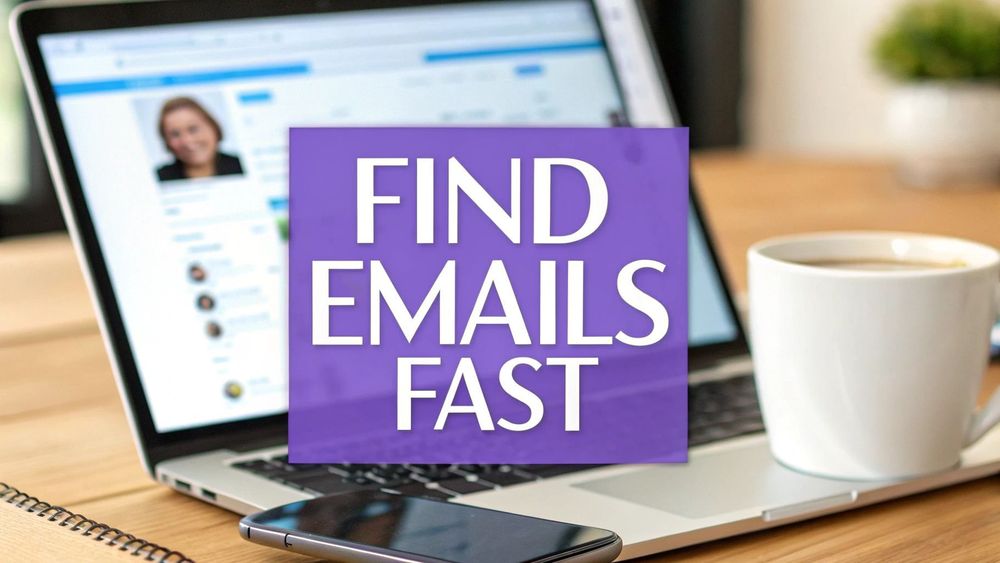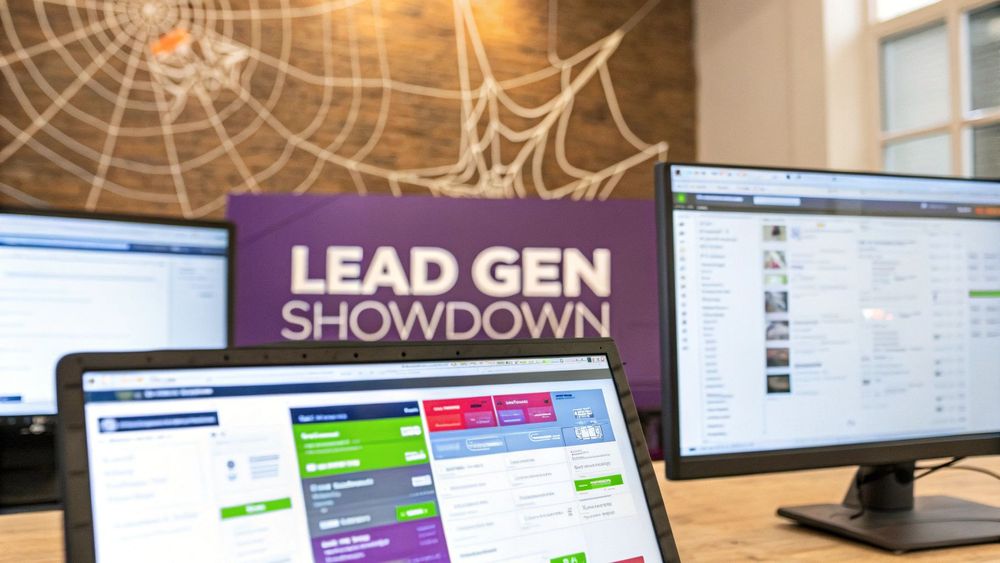Trying to find someone's email address on LinkedIn can feel like a game of cat and mouse. You've got a few classic moves: manually digging through their contact info, taking a wild guess with patterns like firstname.lastname@company.com, or bringing in a specialized browser extension.
But let's be honest, the most effective approach is a mix of smart profile analysis and the right tools to uncover contact details that aren't just handed to you on a silver platter.
The Real Challenge of Email Hunting on LinkedIn
LinkedIn is the world's biggest professional playground, but it's built to keep conversations inside its own fenced yard. For anyone in sales, recruiting, or marketing, this creates a frustrating paradox: you can pinpoint the exact person you need to talk to, but you can't easily reach them on the most powerful channel out there—email.
This isn't a bug; it's a feature.
The platform is engineered to push you toward its own InMail system and is built around privacy settings that intentionally keep direct contact information locked down. This reality forces you down one of a few paths when you want to make a connection.
Before we dive into the specific methods, it's helpful to see the big picture. Here’s a quick comparison of the main ways people try to connect on LinkedIn for serious business outreach.
A Quick Look at LinkedIn Outreach Methods
| Method | What It's Good For | Where It Falls Short |
|---|---|---|
| Manual Detective Work | Zero cost, perfect for one-off searches where you have time to spare. | Extremely time-consuming, unreliable, and simply not scalable for any real volume. |
| LinkedIn InMail | Quick introductions and staying within the LinkedIn ecosystem. Good for initial contact. | Feels less formal, easily ignored by busy execs, and keeps you dependent on LinkedIn's platform. |
| One-Click Tools (like ProfileSpider) | Speed and efficiency. Extracts profile data, including potential emails, in seconds with AI. | Requires a small investment, but the ROI in time saved and accuracy is massive. |
As you can see, each method has its place, but when it comes to building a scalable and professional outreach process, moving the conversation off-platform is key.
This visual breaks down the typical workflow for any kind of LinkedIn outreach.
That infographic drives home a critical point: after you've identified a prospect, the outreach method you choose directly shapes your ability to follow up effectively—something that's far easier to do in your own email client.
Why Moving Off-Platform Matters
Even with LinkedIn's colossal user base of over 1 billion members, getting direct access to personal emails is incredibly rare. The platform is an absolute beast for B2B connections, no doubt. Yet, only about 1% of its monthly users share content on a weekly basis, which tells you that the vast majority are not publicly broadcasting their contact details.
This is exactly why moving conversations into your own email client is so important. It gives you control over tracking, follow-ups, and building a genuine, direct line of communication. If you're curious about the finer points of this kind of data gathering, it's worth reading up on whether website scraping is legal.
Ultimately, a whole ecosystem of manual tricks and specialized tools exists for one reason: to bridge the gap between finding someone on LinkedIn and actually reaching them with a professional email.
Mastering the Manual Search for Emails (The Traditional Method)
Before you jump to a modern, one-click tool, it’s worth understanding the old-fashioned manual method. For sales pros and recruiters, mastering these foundational skills is a game-changer. It helps in one-off situations and makes you appreciate what modern AI profile extraction can do for you later.
The most obvious first stop is the "Contact Info" section on someone's LinkedIn profile. It sounds basic, but you'd be surprised how often people list their email right there, especially if they're open to new gigs or collaborations.
Uncovering Clues Beyond the Obvious
So what happens when the contact info section is a dead end? It’s time to put on your detective hat and dig into the rest of the profile. Professionals often leave breadcrumbs that can lead you straight to their inbox.
- Personal Websites & Portfolios: Scan the profile header and "About" section. Many people link to their personal blogs or portfolios, which almost always have a contact page with a direct email address. Easy win.
- The "About" Section: It’s a bit of a long shot, but sometimes people will drop a call-to-action right in their summary, like "Feel free to reach out at my.email@company.com for collaborations." A quick skim can sometimes pay off big.
- Company Affiliations: This is the big one. Pay close attention to the exact name of their current company. That piece of information is the key to the next step: figuring out their corporate email pattern.
The Art of Deducing and Verifying
Once you have their full name and the company domain (like company.com), you can start making some educated guesses. The good news is that most companies use a standard email format for all their employees.
Pro Tip: Don't just guess one pattern and call it a day. Try several common variations to really up your chances. It’s a numbers game, and being thorough is what separates the pros from the amateurs.
Here are the most common corporate email patterns I always test first:
firstname.lastname@company.comflastname@company.com(first initial, last name)firstname@company.comfirstname_lastname@company.com
After you have a short list of possibilities, the final piece of the puzzle is verification. A simple but surprisingly effective trick is to just Google it. Wrap each email you've guessed in double quotes (e.g., "jane.doe@saascompany.com") and hit search. If that exact email has ever been listed publicly on a company page, an author bio, or a conference speaker list, Google will usually sniff it out. This turns a wild guess into a confirmed lead.
If you really want to go down the rabbit hole with advanced searching, our guide on how to find a person with Boolean searches will give you some powerful new tricks for your toolkit.
While this manual process works well for a single target, you can probably see the bottleneck. It’s a time-sucking loop of analyzing, guessing, and verifying. It’s a great skill to have in your back pocket, but it’s definitely not a scalable way to build out a prospect list.
When to Use InMail and When to Skip It
LinkedIn InMail feels like the obvious first move for outreach, but is it always the right one? If you're in sales or recruiting, figuring out when to stick with InMail versus when to dig for a direct email can make or break your outreach campaign.
Sure, InMail seems like a direct line, but it comes with some serious strings attached. First off, it’s a premium feature, and even then, LinkedIn rations out your credits each month. This built-in scarcity means you have to be incredibly picky about who you contact. Plus, an InMail lives and dies on LinkedIn. For a busy exec who lives in their email inbox, a message on a social platform just doesn't carry the same weight.
The Strategic Value of Direct Email
Let's be honest, the real goal is to get the conversation off the platform and into a channel you control. That's where email shines. It gives you the space for detailed attachments, better formatting, and seamless integration with your CRM or ATS for killer follow-up sequences.
For the important stuff—think formal proposals, detailed job descriptions, or contracts—a direct email is non-negotiable. It signals that you mean business and makes it easy for the recipient to save, forward, and act on what you sent.
Now, LinkedIn will tell you their InMail system has response rates nearly three times higher than traditional email. But there’s a catch. Those messages are often seen as less formal. While the average cold LinkedIn message gets a 10.3% response rate (over double the 5.1% for cold email), this is partly because LinkedIn's spam filters aren't as aggressive.
Herein lies the paradox: while 40% of U.S. marketers call LinkedIn their top B2B lead generation channel, the most critical conversations inevitably move to email. This trend alone shows why, for serious business, email is still king. If you want to dive deeper into these numbers, check out this state of LinkedIn outreach for 2025 report.
Making the Right Choice
So, how do you decide? It really boils down to your goal and where you are in the relationship.
Use InMail for:
- Quick, informal intros or networking pings.
- A first touchpoint when you have absolutely no other way to reach them.
- Adding some context right after they accept your connection request.
Prioritize finding an email for:
- Sending formal business proposals or beefy documents.
- Official recruiting outreach that includes a full job description.
- Building a direct line of communication that you actually own.
- Plugging contacts into your CRM for systematic follow-ups.
In the end, InMail is a great tool for that initial handshake. But the real strategic advantage comes from getting that direct email address. It gives you ownership of the relationship and the power to communicate like a pro, making the hunt for a real email totally worth the effort.
Ditch the Grind with a One-Click Solution: ProfileSpider
If you’ve ever tried hunting for emails manually, you know the pain. It's a slow, repetitive slog of guessing, verifying, and hoping for the best. That approach just doesn't work when you need to build a real sales pipeline, find top-tier candidates, or launch a marketing campaign.
This is exactly where a modern, no-code scraping tool like ProfileSpider flips the script. It takes what used to be hours of tedious labor and shrinks it down to a single click.
Instead of you having to play detective on every LinkedIn profile, ProfileSpider's AI-powered engine does all the heavy lifting in an instant, turning a manual chore into a simple, automated workflow.
Put the Entire Discovery Process on Autopilot
Picture this: as a recruiter, you've just run a LinkedIn search and have a page full of perfect software engineer candidates. The old way meant clicking into each profile, one by one, scanning for clues, and manually copying everything into a spreadsheet. Yikes.
With a tool like ProfileSpider, your workflow looks completely different.
You just click one button, and the extension springs to life. Its AI engine scans the entire page, pinpoints every profile, and extracts all the available data in a matter of seconds. This isn't just about emails; you get the full picture:
- Full Names and Job Titles: The basics, captured instantly without any typing.
- Company Information: Know exactly where everyone works, which is a huge clue for figuring out email patterns.
- Location Data: Segment your lists by geography for hyper-targeted outreach.
- Contact Information: When public, it grabs emails and phone numbers directly.
- Social and Professional Links: Pulls in links to personal sites, GitHub, or Twitter, giving you more ways to connect and research.
Here’s what that one-click extraction actually looks like in action.
As you can see, the results are clean, immediate, and neatly structured—ready for export to your CRM or ATS.
A Privacy-First Approach to Data
Let's be real: when you hear "automated tool," data privacy concerns often come to mind. Where is my data going? Who can see it? ProfileSpider tackles this head-on with a privacy-first design.
All the data you extract is stored locally in your browser's IndexedDB. Nothing is ever sent to an external server without your explicit consent. This means you maintain complete control over your data, ensuring you stay compliant with regulations like GDPR.
This local storage model gives you the speed of automation without compromising the security or ownership of your hard-won leads.
Let's go back to our recruiter. They need to build a list of 50 software engineers from a LinkedIn search. Done manually, that’s an entire afternoon down the drain. With ProfileSpider, they go to the results page, hit "Save profiles," and extract all 50 profiles in less than a minute.
The data is then perfectly organized and ready for export to their Applicant Tracking System (ATS) or CRM. This is the real magic—it's not just about speed, but about building a repeatable, efficient system for lead generation. To see how this works under the hood, check out our ProfileSpider deep-dive. That simple, one-click process is what makes it the go-to AI profile extraction tool for pros who value their time.
Picking the Right Tool for the Job
While a one-click solution like ProfileSpider gives you a clean, straightforward way to pull profile info, it’s worth understanding the bigger picture of email-finding tech. The market is packed with options, from simple browser extensions to massive enterprise data platforms. Which one is right for you really boils down to what you need in terms of accuracy, volume, and—most importantly—staying on the right side of the law.
You have to keep a sharp eye on legal and ethical lines, especially with data privacy laws like GDPR and CCPA in play. Generally, tools that work with publicly available data are the safer bet. The ones that get aggressive, scraping non-public info in ways that violate a platform's terms of service, carry some serious risks. You could even get your account suspended.
Accuracy and Verification Are Non-Negotiable
One of the biggest headaches is that accuracy can be all over the place. Some tools are basically just guessing common email patterns (firstname.lastname@company.com), while others are much more sophisticated, cross-referencing multiple databases to confirm an address actually works. This is exactly why you can't skip the verification step.
Key Takeaway: An unverified email is just a guess. Firing off messages to bad addresses jacks up your bounce rate, which tanks your domain's reputation and sends your future outreach straight to the spam folder.
Once you have a list of potential emails, you absolutely have to run them through dedicated email verification tools. This extra step confirms the addresses are deliverable and keeps your sales or marketing campaigns healthy.
Solving the Compliance Puzzle
The legal and technical hoops you have to jump through to get emails have led to a boom in specialized software. These tools often blend LinkedIn data with other public sources to figure out or confirm an email address. But—and this is a big but—they vary wildly in how they handle global data protection laws.
With over 69 million companies on LinkedIn, the platform is a goldmine for prospecting but a real puzzle for direct outreach. This reality reinforces its role as a hub for professional introductions, not just a simple phonebook. You can learn more about the complexities of LinkedIn email discovery on reply.io.
This is where a privacy-first tool becomes so valuable. ProfileSpider, for example, is built to prioritize your data control. It stores all the information it extracts locally in your browser, not on some third-party server.
This approach means you stay in complete control of your data, making it much easier to align with privacy rules while still hitting your lead generation targets. It’s all about building your lists efficiently and ethically.
Got Questions? We’ve Got Answers
Figuring out the do's and don'ts of finding emails on LinkedIn can feel like walking a tightrope. So, let’s clear up a few of the most common questions that pop up for sales pros, recruiters, and marketers.
Is It Actually Legal to Find and Use Emails from LinkedIn?
Here’s the deal: finding an email address that's publicly available isn't the issue. The real question is how you use it. For legitimate business reasons—like sending a personalized job offer or a genuinely relevant sales proposal—you’re generally in the clear.
The trouble starts when you slide into spam territory. Sending unsolicited bulk emails can get you in hot water with regulations like the CAN-SPAM Act or GDPR.
The key to staying on the right side of the line is simple:
- Make your outreach personal.
- Make sure it offers real value to the person you're contacting.
- Always give them an easy way to opt out.
A Quick Word of Caution: Be wary of tools that scrape data aggressively behind the scenes. Using them can get you in trouble with LinkedIn's terms of service. It's much smarter to stick with methods that use public information or intelligent guesswork.
What's the Best Way to Know If a Guessed Email Is Real?
Hands down, the most reliable way is to use a dedicated email verification service. These tools check if an email is deliverable and healthy without actually sending a message, which is crucial for protecting your sender reputation.
But if you need a quick, no-cost check, a simple Google search works wonders. Just wrap the email address in quotation marks (like "j.smith@abccorp.com") and hit search. If that email has ever been listed on a company's "About Us" page, in an author's bio, or on a conference speaker list, Google will probably find it. It's a surprisingly effective trick.
Can LinkedIn Actually Ban My Account for This?
Let’s be direct: yes, they can, but it depends entirely on how you do it. LinkedIn’s user agreement is crystal clear about banning automated software—or "bots"—used for scraping data. If you use an aggressive tool that hammers their site with a crazy number of requests, you're practically asking to get your account flagged or shut down.
So, what's safe?
Manual searches are perfectly fine. You're just using the platform as intended.
Browser extensions like ProfileSpider are designed to be a much safer middle ground. They operate locally in your browser and are built to mimic how a real person would search, not a robot. This approach drastically lowers the risk while still giving you the speed and efficiency you need to find contacts without putting your account on the line.




